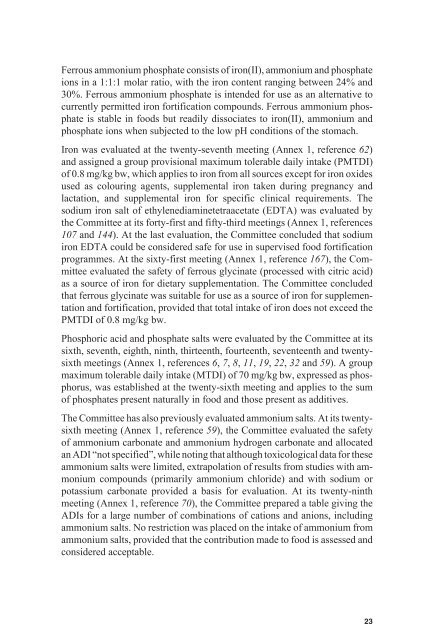evaluation of certain food additives - libdoc.who.int - World Health ...
evaluation of certain food additives - libdoc.who.int - World Health ...
evaluation of certain food additives - libdoc.who.int - World Health ...
You also want an ePaper? Increase the reach of your titles
YUMPU automatically turns print PDFs into web optimized ePapers that Google loves.
Ferrous ammonium phosphate consists <strong>of</strong> iron(II), ammonium and phosphate<br />
ions in a 1:1:1 molar ratio, with the iron content ranging between 24% and<br />
30%. Ferrous ammonium phosphate is <strong>int</strong>ended for use as an alternative to<br />
currently permitted iron fortification compounds. Ferrous ammonium phosphate<br />
is stable in <strong>food</strong>s but readily dissociates to iron(II), ammonium and<br />
phosphate ions when subjected to the low pH conditions <strong>of</strong> the stomach.<br />
Iron was evaluated at the twenty-seventh meeting (Annex 1, reference 62)<br />
and assigned a group provisional maximum tolerable daily <strong>int</strong>ake (PMTDI)<br />
<strong>of</strong> 0.8 mg/kg bw, which applies to iron from all sources except for iron oxides<br />
used as colouring agents, supplemental iron taken during pregnancy and<br />
lactation, and supplemental iron for specific clinical requirements. The<br />
sodium iron salt <strong>of</strong> ethylenediaminetetraacetate (EDTA) was evaluated by<br />
the Committee at its forty-first and fifty-third meetings (Annex 1, references<br />
107 and 144). At the last <strong>evaluation</strong>, the Committee concluded that sodium<br />
iron EDTA could be considered safe for use in supervised <strong>food</strong> fortification<br />
programmes. At the sixty-first meeting (Annex 1, reference 167), the Committee<br />
evaluated the safety <strong>of</strong> ferrous glycinate (processed with citric acid)<br />
as a source <strong>of</strong> iron for dietary supplementation. The Committee concluded<br />
that ferrous glycinate was suitable for use as a source <strong>of</strong> iron for supplementation<br />
and fortification, provided that total <strong>int</strong>ake <strong>of</strong> iron does not exceed the<br />
PMTDI <strong>of</strong> 0.8 mg/kg bw.<br />
Phosphoric acid and phosphate salts were evaluated by the Committee at its<br />
sixth, seventh, eighth, n<strong>int</strong>h, thirteenth, fourteenth, seventeenth and twentysixth<br />
meetings (Annex 1, references 6, 7, 8, 11, 19, 22, 32 and 59). A group<br />
maximum tolerable daily <strong>int</strong>ake (MTDI) <strong>of</strong> 70 mg/kg bw, expressed as phosphorus,<br />
was established at the twenty-sixth meeting and applies to the sum<br />
<strong>of</strong> phosphates present naturally in <strong>food</strong> and those present as <strong>additives</strong>.<br />
The Committee has also previously evaluated ammonium salts. At its twentysixth<br />
meeting (Annex 1, reference 59), the Committee evaluated the safety<br />
<strong>of</strong> ammonium carbonate and ammonium hydrogen carbonate and allocated<br />
an ADI “not specified”, while noting that although toxicological data for these<br />
ammonium salts were limited, extrapolation <strong>of</strong> results from studies with ammonium<br />
compounds (primarily ammonium chloride) and with sodium or<br />
potassium carbonate provided a basis for <strong>evaluation</strong>. At its twenty-n<strong>int</strong>h<br />
meeting (Annex 1, reference 70), the Committee prepared a table giving the<br />
ADIs for a large number <strong>of</strong> combinations <strong>of</strong> cations and anions, including<br />
ammonium salts. No restriction was placed on the <strong>int</strong>ake <strong>of</strong> ammonium from<br />
ammonium salts, provided that the contribution made to <strong>food</strong> is assessed and<br />
considered acceptable.<br />
23

















